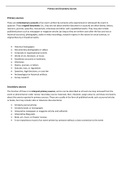Primary and Secondary Sources
Primary sources
These are contemporary accounts of an event, written by someone who experienced or witnessed the event in
question. These original documents (i.e., they are not about another document or account) are often diaries, letters,
memoirs, journals, speeches, manuscripts, interviews and other such unpublished works. They may also include
published pieces such as newspaper or magazine articles (as long as they are written soon after the fact and not as
historical accounts), photographs, audio or video recordings, research reports in the natural or social sciences, or
original literary or theatrical works.
• Historical newspapers
• Documentary photographs or videos
• Corporate or organizational records
• Works of art, literature, or music
• Eyewitness accounts or testimony
• Interviews
• Diaries, journals, or letters
• Statutes, laws, or regulations
• Speeches, legal decisions, or case law
• Archaeological or historical artifacts
• Survey research
Secondary sources
The function of these is to interpret primary sources, and so can be described as at least one step removed from the
event or phenomenon under review. Secondary source materials, then, interpret, assign value to, and draw conclusions
about the events reported in primary sources. These are usually in the form of published works such as journal articles
or books, but may include radio or television documentaries.
• Scholarly journal articles
• Scholarly books or monographs
• Interpretive newspaper or magazine articles and editorials
• Interpretive blog posts
• Book, art, music, or theater reviews
• A non-eyewitness record of an event written by someone without a close connection to the event





